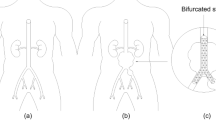Abstract
An electrochemistry-based method for the formation of functionalized alkanethiol layers on a 316L stainless steel surface was developed. The method was efficient in forming a very stable, irreversibly-attached COOH-terminated (mercaptoundecanoic acid) surface layer. This layer was used as a ‘linker’ to immobilize the extracellular matrix protein fibronectin to the 316L stainless steel surface. Fibronectin was irreversibly attached to the surface and, unlike physisorbed fibronectin, resisted detachment more in aggressive 0.1 M NaOH under sonication. The fibronectin-modified 316L stainless steel surface was more biocompatible towards attachment of endothelial cells than a bare (unmodified) 316L stainless steel surface, yielding a 25% improvement in cell density.





Similar content being viewed by others
References
Blindt R, Vogt F, Astafieva I, Fach C, Hristov M, Krott N, Seitz B, Kapurniotu A, Kwok C, Dewor M, Bosserhoff A-K, Berhagen J, Hanrath P, Hoffmann R, Weber C (2006) A novel drug-eluting stent coated with an integrin-binding cyclic Arg-Gly-Asp peptide inhibits neointimal hyperplasia by recruiting endothelial progenitor cells. J Am Coll Cardiol 47:1786–1795
Briand E, Salmain M, Herry J-M, Perrot H, Compère C, Pradier C-M (2006) Building of an immunosensor: how can the composition and structure of the thiol attachment layer affect the immunosensor efficiency? Biosens Bioelectron 22:440–448
Burt H, Hunter WL (2006) Drug-eluting stents: a multidisciplinary success story. Adv Drug Deliv Rev 58:350–357
Elving PJ, Spritzer MS (1965) Polarographic reduction of hydrogen ion in non-aqueous solvents. Talanta 12:1243–1258
Hynes RO (1992) Integrins: versatility, modulation, and signaling in cell adhesion. Cell 69:11–25
Kastrati A, Mehilli J, Pache J, Kaiser C, Valgimigli M, Kelbæk H, Menichelli M, Sabaté M, Suttorp MJ, Baumgart D, Seyfarth M, Pfisterer ME, Schömig A (2007) Analysis of 14 trials comparing sirolimus-eluting stents with bare-metal stents. N Engl J Med 356(10):1030–1039
Lagerqvist B, James SK, Stenestrand U, Lindbäck J, Nilsson T, Wallentin L (2007) Long-term outcomes with drug-eluting stents versus bare-metal stents in Sweden. N Engl J Med 356(10):1009–1019
Liakos IL, Newman RC, McAlpine E, Alexander MR (2004) Comparative study of self-assembly of a range of monofunctional aliphatic molecules on magnetron-sputtered aluminium. Surf Interface Anal 36:347–354
Mani G, Feldman MD, Patel D, Agrawal CM (2007) Coronary stents: a materials perspective. Biomaterials 28:1689–1710
Mansur HS, Orefice RL, Lobato ZP, Vasconcelos WL, Mansur E, Machado JC (2001) Adsorption/desorption behavior of bovine serum albumin and porcine insulin on chemically patterned porous gel networks. Adsorption 7:105–116
Mao Y, Schwarzbauer JE (2005) Fibronectin fibrillogenesis, a cell-mediated matrix assembly process. Matrix Biol 24:389–399
Ohtsuka K, Kuroki M, Nojima T, Waki M, Takenaka S (2005) Interaction analysis of the carcinoembryonic antigen (CEA) with its monoclonal antibody immobilized on a gold surface using Fourier transform infrared reflection-absorption spectroscopy (FT-IR RAS). Anal Sci 21:215–218
Omanovic S, Harvey J, Dadafarin H (2010) Modified stainless steel surface and method for preparing the same using an electrochemical process. USA and Canada Patent application, #61391335, 2011
Patel N, Davies MC, Hartshorne M, Heaton RJ, Roberts CJ, Tendler SJB, Williams PM (1997) Immobilization of protein molecules onto homogeneous and mixed carboxylate-terminated self-assembled monolayers. Langmuir 13:6485–6490
van der Hoeven BL, Pires NMM, Warda HM, Oemrawsingh PV, van Vlijmen BJM, GQuax PHA, Schalij MJ, van der Wall EE, Jukema JW (2005) Drug-eluting stents: results, promises and problems. Int J Cardiol 99:9–17
Wojciechowski P, Ten Hove P, Brash JL (1986) Phenomenology and mechanism of the transient adsorption of fibrinogen from plasma (Vroman effect). J Colloid Interface Sci 111:455–465
Yan L, Marzolin C, Terfort A, Whitesides GM (1997) Formation and reaction of interchain carboxylic anhydride groups on self-assembled monolayers on gold. Langmuir 13:6704–6712
Acknowledgments
The authors would like to thank the Natural Science and Engineering Research Council of Canada and the Canadian Institutes of Health Research for support of this research, through a Collaborative Health Research Program Grant.
Author information
Authors and Affiliations
Corresponding author
Rights and permissions
About this article
Cite this article
Harvey, J., Bergdahl, A., Dadafarin, H. et al. An electrochemical method for functionalization of a 316L stainless steel surface being used as a stent in coronary surgery: irreversible immobilization of fibronectin for the enhancement of endothelial cell attachment. Biotechnol Lett 34, 1159–1165 (2012). https://doi.org/10.1007/s10529-012-0885-8
Received:
Accepted:
Published:
Issue Date:
DOI: https://doi.org/10.1007/s10529-012-0885-8




